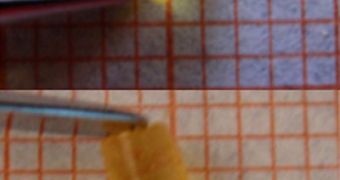A collaboration of investigators from the Kyushu University and the Carnegie Mellon University (CMU) announces the development of a new type of polymer, that can mend itself. Whenever it is damaged, a simple exposure to ultraviolet (UV) light makes it as new again.
The healing process takes place at room temperature, the team behind the new work says, which means that the technology could have some fairly interesting practical applications. These include the development of engine parts that can fix themselves, for example.
Another possible use is in medical implants, which may be capable of reverting to their original shape and functionality if the person wearing them suffers a light accident, Technology Review reports.
Restoring the polymer to its original shape and function is easy, the researchers say. All that is needed is for the broken sections to be held together, and for UV light to shine on them. The same approach can be used to fuse together individual polymer pieces.
CMU chemistry professor Krzysztof Matyjaszewski, the leader of the research effort, says that the polymer the team developed could be broken into pieces and fused back together five times.
But he adds that future versions of the materials could undergo these transformations many times more. Thus far, the group managed to demonstrate that the technology functions, in a proof-of-concept study.
“There are thousands of chemical bonds here, and even if you lose a small percent, one can think about potentially repeating the healing a hundred times,” the team leader adds, mentioning that the basis of the polymer's self-healing ability are the carbon-sulfur bonds it contains.
Matyjaszewski says that the polymer can now only fix itself in an oxygen-free environment. This is why the research group used an ambiance of pure nitrogen when conducting the UV experiments.
But researchers say that the new polymers are in fact just a stepping stone, towards materials that can be treated with visible light, and in an oxygen-rich atmosphere such as the one we live in.
The team leader believes that such an innovative material “would be a dramatic improvement over what we've already done.” Varieties of polymers and composites are the only self-healing materials obtained to date.
“You can make materials that are harder or softer. Every self-healing material is somehow unique and has advantages over the other ones. It depends on the properties and area of application,” Matyjaszewski adds.
Details about the recent achievement were published in the latest online issue of the esteemed scientific journal Angewandte Chemie.

 14 DAY TRIAL //
14 DAY TRIAL //